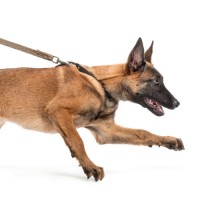 As with any problem behaviour your dog is displaying, the first step to changing the lead pulling is determining what is causing it.
As with any problem behaviour your dog is displaying, the first step to changing the lead pulling is determining what is causing it.
Is it a training problem, whereby your dog learnt as a puppy that if it pulled in a certain direction, the person on the other end of the lead followed?
Is it excited about getting to an off-lead destination and therefore pulls on the way a lot more than on the way back?
Is it aroused by stimuli on walks such as squirrels or cats and is constantly focused on these, whether they are present or not?
Is your dog anxious on walks, possibly because it is fearful of something that is sometimes encountered on walks, for example, traffic, people or other dogs?
Does your dog pull towards smells or to urine mark
The answer to lead pulling depends entirely on what is motivating your dog to pull. Of course you can always try to deal with the problem by changing the equipment and/or by trying to simply counteract the pulling. However, these techniques can have negative consequences.
Certain equipment appear to solve the lead pulling problem because they are uncomfortable for the dog when they try to pull – certain types of harnesses and collars, for example, tighten or dig into pressure points when the dog pulls. Other equipment such as headcollars or Haltis provide the handler with more control with which to pull against the dog when used incorrectly. The pulling can also attempt to be punished by jerking the dog on the lead whenever it pulls. This technique takes a lot of skill and therefore is frequently ineffective. However, what happens when you attempt any of these techniques but your dog is pulling because it is anxious or fearful? What happens when you attempt these techniques when your dog is excited or aroused, but due to the constant anticipation of pain or discomfort caused by the equipment or handler it starts to become increasingly anxious on walks? You may have succeeded in making one problem a lot worse.
So what can you do to stop lead pulling?
Firstly, prevention is better than cure! Your puppy needs to learn that you only walk in the direction they want to go in when the lead is slack. All that means is that you stop walking when the lead goes tense, and walk again as soon as the lead is loose – following the puppy acts as a reward (it gets to move in the direction it wants to go). You also need to highly reinforce the puppy when it is walking on a loose lead. Use a marker word to tell the pup when it is doing the right thing (nothing technical here, “good!” will do!) followed by the delivery of a small treat. Reward frequently – every second to start with, gradually allowing longer between each reinforcement.
You can use the same technique to try to address the problem, but there will inevitably be more issues to deal with first. If your dog is stressed/anxious/aroused/excited, it is not going to be in an optimum state for learning, and it may not even take treats.
If your dog is anxious/fearful, the root of the fear needs addressing. If your dog is aroused by squirrels, this also needs addressing separately. If your dog is excited about getting to a certain destination, try making the destination more boring (i.e. don’t let them off for a free play), make the rest of the walk more interesting (interact with your dog with games or training), and change the route and predictability of your walk.
Frequently the equipment has to be changed in order to improve the lead pulling because the dog has learnt a negative association with the current equipment – no matter what equipment has been used, pulling against it would have been uncomfortable or painful for the dog. Certain front point harnesses are often beneficial if introduced with the lead walking technique outlined above. (Back-attachment harnesses actually give the dog a better centre of gravity to pull into). Headcollars or Haltis can be used, but they must be introduced gradually and positively otherwise the dog will attempt to remove it and can become highly stressed. The handler also needs guidance in how to use these appropriately.
So you can see, lead pulling often isn’t as simple as being a common training problem. It is frequently much deeper rooted and requires a qualified behaviourist to diagnose the problem and provide practical support to help.